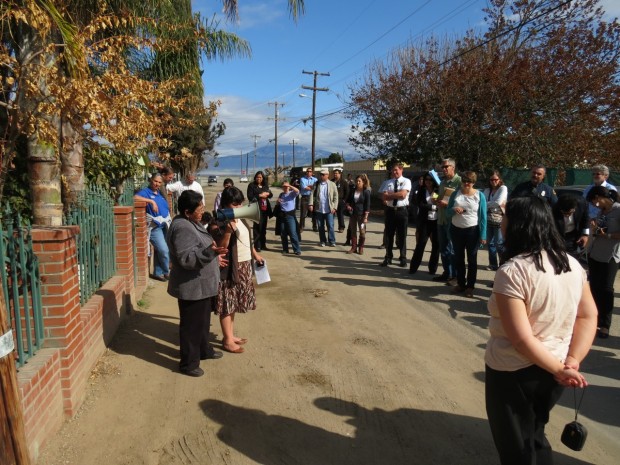Cal/OSHA fined the company following the workers’ deaths, but community members say the accident may have been prevented if workers on site or nearby residents knew how to file a complaint about environmental hazards at the plant.
As the bus leaves the site, passengers strain to make out the Sierra Nevada mountains, masked by a thick curtain of smog. Next stop? Weedpatch, where nearly thirty trailer homes lack sewer hook-ups.
Francisco Perez lives here with his three children and four grandchildren. He sheepishly explains that when their septic tank fills up, and they can’t afford to clean it out, they go to the bathroom in a bucket and dump their waste in plastic bags in the trash.
“It makes me sad,” he says in Spanish. “In Mexico, when they’re going to build a neighborhood, the first thing they do is put in a sewer system. And Mexico is so poor compared to the U.S.”
Perez says he doesn’t know who to call to find out when the local utility district plans to connect his house to the sewer or if there’s a program to help low-income residents pay to drain their septic tanks.
The government officials and nonprofit advocates on this bus tour teamed up to launch the new website. Ultimately, it will be bilingual and they hope it can help Kern County residents like Perez. The site lets people text anonymous complaints and pictures of pollution or hazards in their communities. A central ‘problem solver’ will funnel those complaints to the right agencies.
Back on the bus, Brian Johnson of the state Department of Toxic Substances Control tells me residents shouldn’t be expected to know who to call when they smell chemicals wafting through the air or see an abandoned car rusting by the side of the road. The onus, he says, should be on the government.
“Once we, government, get that complaint, it’s up to us to get that into the right silo, to make sure the right people are coming out to fix the problem in the community,” says Johnson over the roar of the bus engine. “They don’t need to know who to call. All they need to know is to go to that website, and they can lodge their complaint.”
Johnson’s agency has just a hundred inspectors statewide to track hazardous waste. He says since the website will map reports of pollution, agencies like his can start to recognize ‘hot spots.' Then they can more effectively target resources. The site also lets residents keep track of how and when regulators respond to their complaints.
The bus tour ends at the Lamont library, where residents come to meet the officials and hear about the project. Teresa DeAnda tells a story about trying to complain when a farmer sprayed pesticides close to her rural home. It was a day when the San Joaquin valley smog was already making it hard to breathe, and her kids were getting headaches.
“So I called Sacramento Department of Pesticide Regulation and they said, ‘We’re not in charge of the air,’ and I said, ‘who is?’ and they said, ‘The California Air Resources Board,’” De Anda explains. “And so I called the California Air Resources Board, and they said, ‘Well, we’re not in charge of pesticides,’ and I go ‘well, then who do I call to tell this guy not to be spraying when the air quality is so bad? My kids are getting sick.'”
Now a community activist, De Anda is helping to launch the website, so complaints like hers don’t get bounced into a bureaucratic black hole.
“Someone’s got to be responsible, here, right? We have this alphabet soup of government agencies,” says Jared Blumenfeld, regional director of the U.S. Environmental Protection Agency, which is helping to fund the website. “To me, government is just, whether it’s local state, county, federal, we’re all just government. We’re paid for by your taxes, out of your pocket, so we might as well work together and get the job done.”
The crowd of residents at the library, many wearing translation devices in their ears, listens carefully. “You are the community environmental police, that’s your job, Blumenfeld tells them. “You are the eyes and ears for all of our agencies. We don’t have enough boots on the ground to find out all the things we need to.”
Projecting an image of the website onto a screen in the library, Ryan Atencio also with the state's Department of Toxic Substances Control demonstrates how the web works, reading a recent complaint sent in to the site.
“This was actually the sulfur spill in Bakersfield that was submitted,” Atencio tells the audience. “Hazardous condition, yellow powder in the roadway, on 23rd and C, a 50-pound bag of sulfur fertilizer, broken…”
Atencio acted as the ‘problem solver’ for a pilot project in Imperial County and the Coachella Valley two years ago. Residents there have used that website to report 170 complaints, leading to more than $70,000 dollars in penalties and fines.
The coalition of agencies and nonprofits launching the new Kern Environmental Enforcement Network hopes it spawns similar efforts across the state.
But there are challenges. How do you get farmworkers with no computers or cell phone cameras to tap into a website? Organizers are setting up a message hotline so people can also phone in reports. In addition, they plan to hold community meetings where residents can get help navigating the Internet to file environmental complaints.
